North America Air Defense System (part of 3)
In 1957, as part of a bilateral agreement signed by the governments of the United States and Canada, the United American-Canadian North American Air Defense Command (NORAD - North American Air Defense Command) was created. At the time of its inception, NORAD led the operations of the USAF Air Defense Command, Canadian aviation Command (Canadian Air Command), Air Defense Forces of the Navy (Naval Forces CONAD / NORAD) and Command of the Army Air Defense Forces (Army Air Defense Command). The NORAD headquarters is located in a nuclear shelter in a fortified bunker, inside Mount Cheyenne in Colorado, in the vicinity of Colorado Springs.
The peak of its power NORAD reached in the first half of the 60-s. Then, in the interests of this structure, hundreds of ground-based radars functioned in the United States and Canada, dozens of DRLO aircraft and radar patrol vessels were on duty in the sea and in the air, more than a hundred and fifty anti-aircraft missile systems were deployed in the US and Canadian territory, and the US-Canadian fleet fighter interceptors exceeded 2000 units. All this cumbersome expensive farm was designed to protect Soviet strategic bombers from about 200.
As it was already said in the first two parts, in the middle of the 60-s, after setting several tens of ICBMs on combat duty in the USSR, it was they, and not the bombers, who became the main threat to the continental United States. Here is how the US Secretary of Defense James Schlesinger spoke out regarding the Soviet nuclear threat and the need to maintain and deploy new air defense systems:
Nevertheless, the Americans did not completely abandon the defense of their air borders. The F-86D, F-89 and F-94 subsonic interceptors were replaced by the supersonic F-101 Voodoo, F-102 Delta Dagger, F-106 Delta Dart, F-4 Phantom II. The first supersonic F-102, which later became one of the most common US Air Force fighters, began combat duty in the middle of the 1956 year.
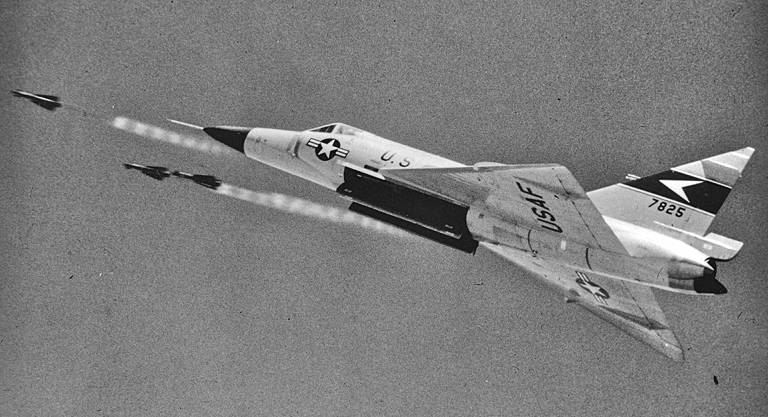
Volley launch of the AIM-4 Falcon with the F-102A interceptor fighter
The F-102 is notable for the fact that it was the first serial supersonic fighter with a delta wing. In addition, he became the first interceptor integrated into a unified system of guidance and application weapons SAGE. In total, the USAF received more than X-NUMX F-900 interceptors. The operation of these aircraft continued until the 102 year.
As for the "Voodoo", their service in the US Air Force was not too long. The first F-101B interceptors began to arrive in the air defense squadron at the beginning of 1959. However, they did not fully arrange the military, as during the operation numerous defects were revealed. Most complaints were caused by the fire control system, since it did not meet modern requirements.
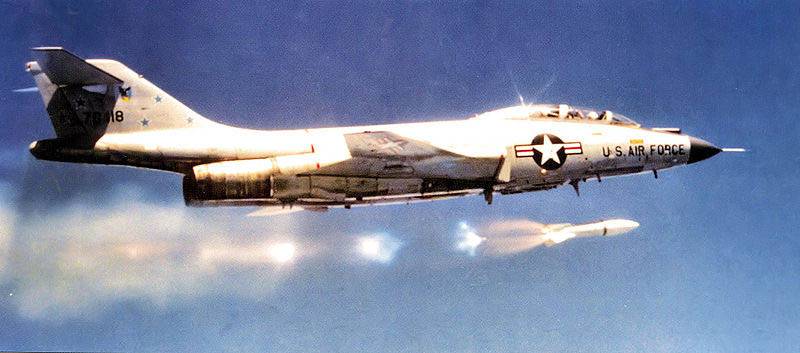
Training run "nuclear" NAR AIR-2A with conventional warheads on board the interceptor F-101F
The generals of the Air Defense Command had plenty to choose from: in 1968, the number of squadrons armed with the F-101B interceptors had been reduced from 15 to 6. However, in the US National Guard, these cars were delayed until the 1983 year. For a long time, Voodoo was the main interceptor in the Royal Canadian Air Force. The first interceptors, the single CF-101B and the double CF-101F, reached alert in Canada in the 1962 year. In the Royal Canadian Air Force aircraft were in service with five air squadrons. In order to compensate for the “natural loss” in flight incidents and to develop the flight resource in November 1970, 66 of the new CF-101 was obtained from the Davis-Montan storage base. At the same time, Canadians returned to the US 56 extremely worn CF-101В and CF-101F. As was already mentioned in the 1, the Canadian interceptors were armed with missiles with nuclear warheads. Formally, these missiles were considered American, and Canada continued to declare its nuclear-free status.
In the Canadian Air Force, “Voodoo” as an interceptor was exploited until the 1984 year. In general, it is necessary to recognize that Canadians did not select the most successful aircraft for arming their air defense squadrons. For the Canadian Air Force, the F-104 Starfighter was selected as a multipurpose fighter, including for air defense missions. The modification CF-104S (CL-90) was built under license from Canadair Ltd. This car had a lot in common with the West German F-104G. Total Canadair for the Canadian Air Force built 200 СF-104.
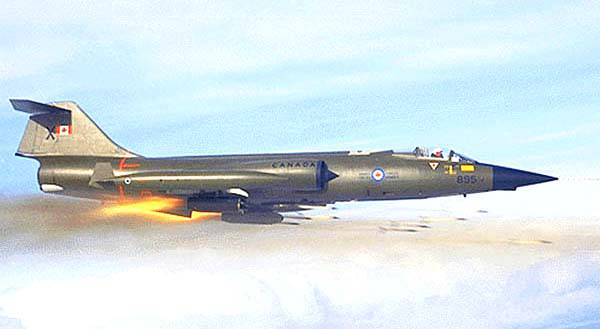
After the cancellation of the F-101 fighter jets in Canada, the Starfighters remained for some time in this country the only type of combat aircraft capable of carrying out air defense tasks. In the 1987, all the CF-104s that were in flight condition were transferred to Turkey. During the years of operation of the “Starfighters” in the Royal Canadian Air Force, 25 pilots died in plane crashes. For the sake of fairness, it’s worth saying that, compared to Voodoo, Starfighter had a more versatile armament: there were 20-mm six-barreled gun M61A1 and UR AIM-9 Sidewinder with a thermal homing head for hitting air targets. In the fighting in Vietnam, where the Americans were trying to use the F-101 and F-102 fighters with the AIM-4 Falcon's UR against MiGs, the Sidewinders were superior to the Falcons. Therefore, AIM-4 missiles in Canada were used only on CF-101B / F. However, the traditional for American and Canadian interceptors 70-mm NAR FFAR as part of the weapons also remained.
A further development of the F-102 Delta Dagger was the F-106 Delta Dart. The first modification of the F-106A arrived on combat duty in October1959. In two years, the X-NUMX single-seater F-277A and 106 2-seater F-63B were built. This is several times less than the number of built F-106 and F-101, however, due to constant improvements and upgrades, F-102 remained in service for more than 106 years. Their final write-off from parts of the US National Guard took place in 20.
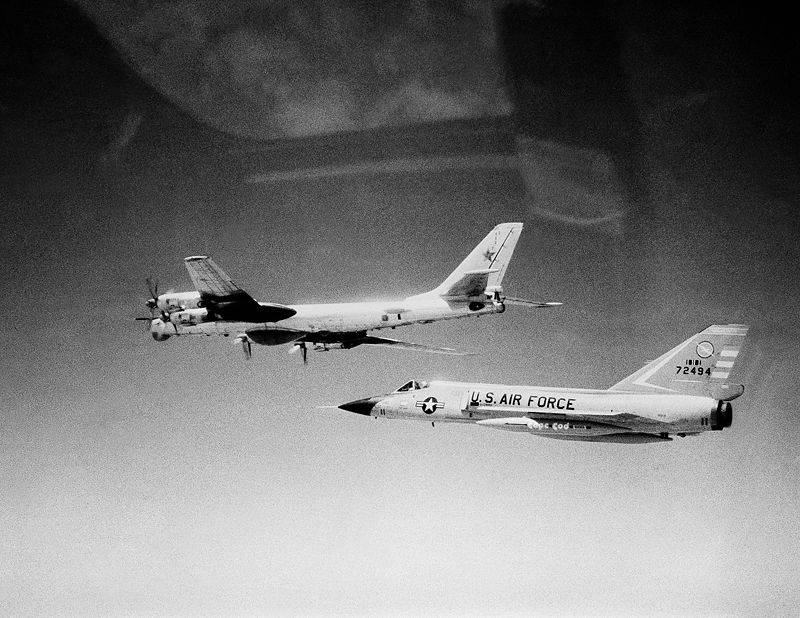
F-106A accompanies the Soviet long-range bomber Tu-95. Photo taken in 1982 year, near the northeast coast of the United States opposite the Cape Cod Peninsula.
This duration of service, despite the relative scarcity, was associated with several circumstances. In the fighter "Delta Dart" managed to get rid of many of the shortcomings inherent in the "Delta Dagger." At the same time, the flight speed of the F-106 increased to 2455 km / h (2,3М), with a combat radius of about 2000 km. The plane had very good acceleration characteristics, the 17680 ceiling, he typed in 450 seconds. Interceptor enjoyed success among the pilots, it was easy to manage and enjoyable for flying the plane. At the height of its popularity, the F-106 was armed with the 13 squadrons of the Air Force Command Air Force. To all of this, Delta Darta was equipped with very advanced avionics, even by the standards of the mid-80. Of all the fighter-interceptors of the “hundredth” series, the capabilities of the Sage automated guidance system were implemented to the maximum extent possible on the F-106. The computerized fire guidance and control system installed on the F-106 carried out the withdrawal to the target area, controlled the entire process, from capturing the target to launching missiles. The pilot could only authorize the launch of missiles and take off and landing. Another interesting feature of this interceptor was the placement of two NARs of the air-to-air class with the nuclear warhead AIR-2 Genie in the internal containers. Based on the combat experience gained in Southeast Asia, starting from 1973, the F-106 front-yard during the factory repairs began to be equipped with the 20-mm six-barreled M61A1 aircraft cannon.
Before the advent of the 4 generation of fighters, the most advanced interceptor in the US Air Force was the F-4 Phantom II. Initially, the customer of this aircraft was the Navy, but under pressure from Defense Minister Robert McNamara, who wanted to standardize the fighter fleet and reduce operating costs, "Phantom" was adopted by the Air Force. The first fighters, known as the F-110A, entered service in November 1963. Soon the plane was renamed the F-4C. Comparative tests with the F-106 demonstrated that the Phantom can carry more air combat missiles. His radar could detect targets at a range of 25% more, while operating the Phantom costs a third less. And most importantly, in spite of the fact that the Phantom airborne unit was not so deeply integrated into the Sage interceptor targeting system, the capabilities of the radar and armament made it possible to bombard enemy bombers from a greater distance.
"Phantom" was the first serial fighter in the world, carrying medium-range air combat missiles. In addition to the 4 AIM-9 Sidewinder melee, the 4 medium-range AIM-7 Sparrow missiles with a semi-active radar seeker could also be part of its weapons. Beginning with 1963, the production of AIM-7D / E modifications with a launch range of more than 30 km in the forehead has been carried out. The Sparrow missiles in the middle of the 60-x were equipped with a core warhead weighing 30 kg and non-contact fuses. Compared to the standard UM AIM-4 Falcon interceptor, the AIM-7 Sparrow rocket had much better combat performance. After the F-4E modification in the avionics had switched to a more compact and lightweight radio-electronic element base in the nose of the aircraft, a place was made for the built-in 20-mm six-barreled gun. Prior to this, the aircraft gun and projectiles were hung in a special gondola on the external sling under the fuselage.
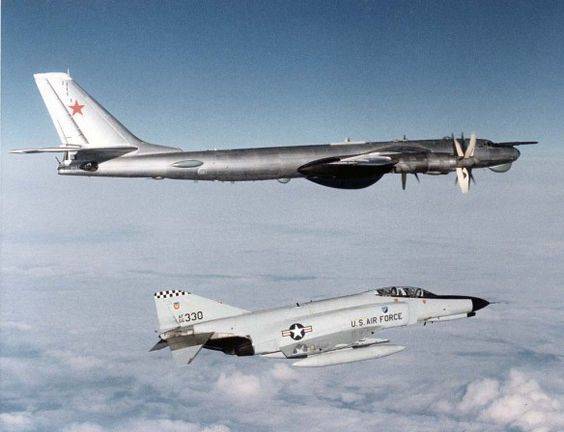
Although the F-4 Phantom II was used more in the US Air Force as a fighter-bomber and during the Vietnam War it became known as a fighter of air superiority, there was also a job for him in the air defense squadrons. In 60-80-ies, "Phantoms" repeatedly rose to meet the Soviet long-range bombers Tu-95, approaching the east coast of the United States during training flights. High flight data, combined with powerful weapons and advanced on-board radio-electronic complex provided this aircraft with an enviable longevity. The last F-4 Phantom II in the United States was written off at the start of the 90's. Total US Air Force received 2874 "Phantom."
As mentioned in the first part, in the USA, billions of dollars were spent on the development of the air defense system from the middle of the 50 to the beginning of the 60. The entire territory of the United States was divided into air defense sectors that were under the responsibility of regional command centers.
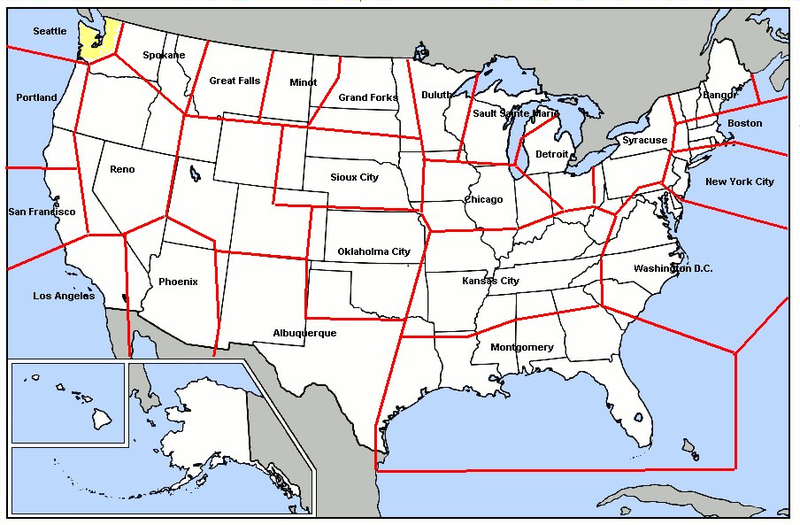
But even for the American economy, the creation and maintenance of a multi-level system of monitoring the air situation, numerous interceptors and air defense systems was a serious burden. Especially expensive was the operation of dozens of long-range radar patrol ships and DRLO EC-121 airplanes. It is known that the deployment of all elements of NORAD cost more than the Manhattan project. Wanting to reduce the costs associated with obtaining radar information far from their shores, in the United States at the end of 50-x and the beginning of 60-5, five “radar pickets” were built based on offshore oil drilling platforms. Radar platforms, also known as the "Texas Towers", were permanently installed in the open sea at a distance of several hundred kilometers from the east coast of the United States and Canada.
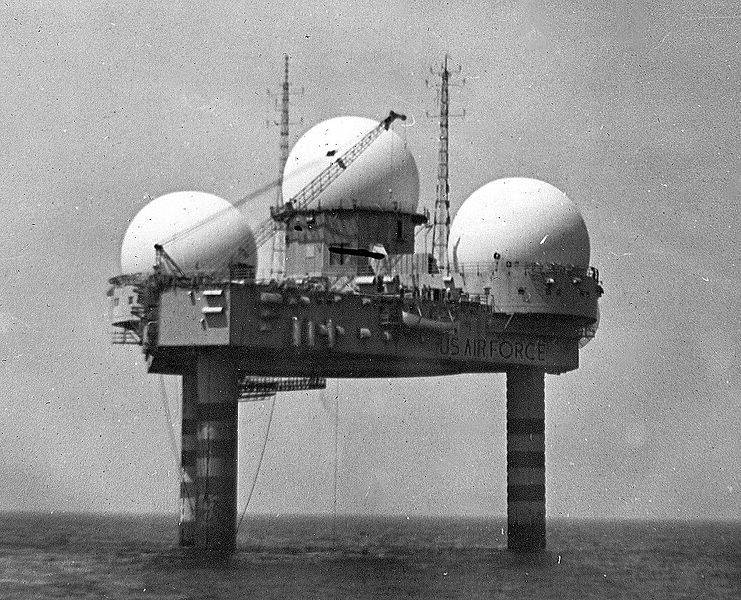
The Texas Towers used powerful radars AN / FPS-24 and AN / FPS-26, covered with weatherproof plastic domes. Delivery of shift personnel, supplies and fuel was carried out by the supply ships of the US Navy. In 1961, one of the radar towers was destroyed during a heavy storm, which was the formal reason for taking them off duty. The last “Tower of Texas” was deactivated in 1963. In fact, the main reason for the abandonment of the offshore radar patrol platforms was their irrelevance, since they could not record the launches of ICBMs. Due to damage, two platforms were flooded.
The DEW-line and the Sage system were an integral part of the North American global air defense system NORAD. The work of the automated interceptor guidance system and the processing of radar information from various radars was carried out by the AN / FSQ-7 computer systems on a lamp element base.
The computing system created by IBM was the most cumbersome ever built. The computer complex of two AN / FSQ-7 operating in parallel weighed 250 tons and contained about 60000 vacuum tubes (49000 in computers), consuming up to 3 MW of electricity. The performance of the computer was about 75 000 operations per second. A total of X / NUMX AN / FSQ-24 units were built. The further development of AN / FSQ-7 was the defense data processing systems AN / FSQ-7, AN / GPA-8 and AN / FYQ-37.
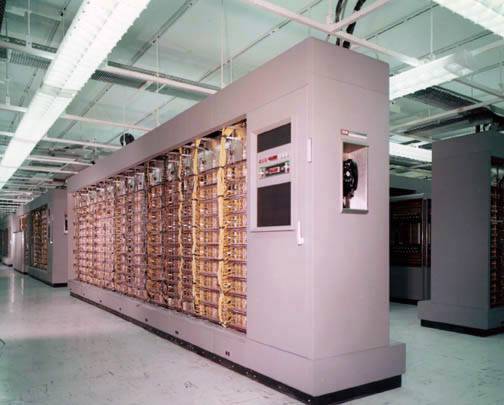
The use of lamp computers of this size was a very expensive pleasure, all the more so because maintaining the data processing and transmission system, taking into account the low reliability of the first computing systems, multiple redundancy and duplication was required.
Operation of the upgraded tube computers continued until the beginning of the 80-s, they were finally written off after the abandonment of the centralized automated Sage interceptors guidance system. After the Sage system was declared obsolete, at the end of 70-s, the development of the AN / FYQ-93 solid-state command and control system based on one Hughes H5118ME host computer and two Hughes HMP-1116 peripherals began. The AN / FYQ-93 operation began in the 1983 year and lasted until the 2006 year. Unlike the Sage equipment, the new CICS did not provide automated interceptor guidance, but only displayed the air situation and transmitted it to other regional command centers of NORAD.
After refusing to carry out permanent combat duty by DRLO aircraft and radar patrol ships, the main burden of issuing information on air targets and targeting interceptors was assigned mainly to stationary ground radars. The AN / TPS-43 and AN / TPS-72 radars available to the US air defense units deployed in the United States did not continuously monitor the air situation and were deployed only during exercise or in crisis situations.
In 70, the American radar network was based on radar AN / FPS-24, AN / FPS-26, AN / FPS-35 and further development options AN / FPS-20 - AN / FPS-66, AN / FPS-67, AN / FPS-93. In the middle of 70-x in Alaska, in Canada and in the continental part of the United States, about 250 medium and high-power radars operated. Canadian radar posts were funded from the US budget.
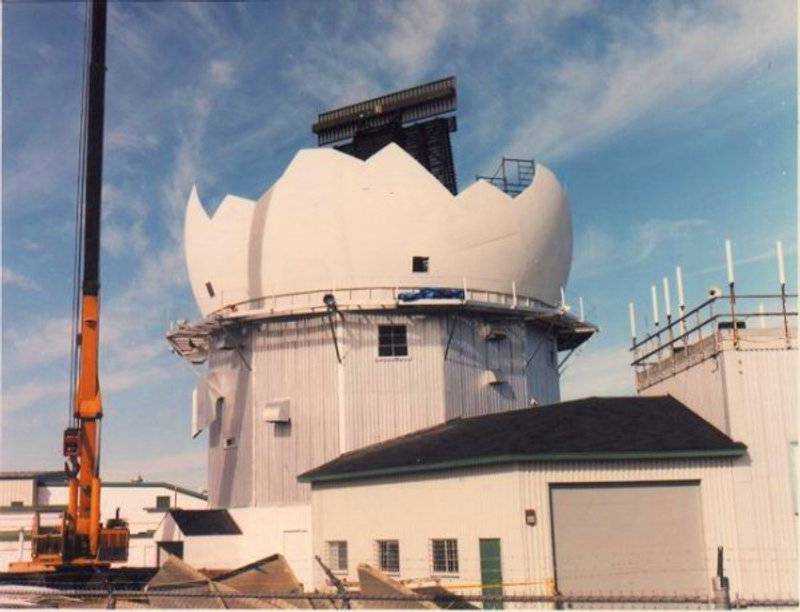
In the middle of the 80-x, a three-dimensional AN / FPS-117 radar with AFAR was adopted by the American armed forces. Modifications of this station are widely distributed both in the NORAD radar warning network and among US allies. The detection range of high-altitude targets for radar AN / FPS-117 can reach 470 km. In the middle of 80-x, the North Warning System (NWS) came to replace the DEW-line in Alaska and Canada. The basis of this system consists of radar AN / FPS-117 and AN / FPS-124.
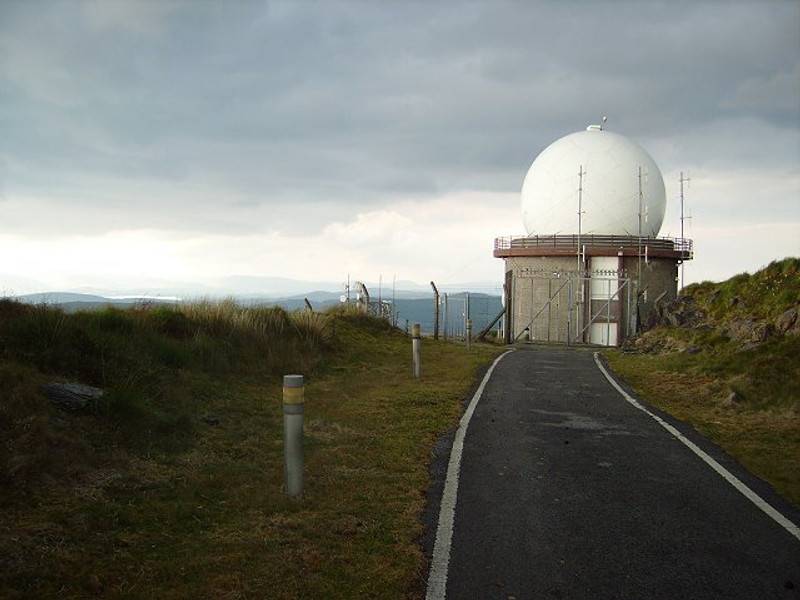
The AN / FPS-117 radar used as part of the North system was developed by Lockheed-Martin specialists based on the AN / TPS-59 radar, which is in service with the United States KMP. The AN / FPS-117 family of radars is distinguished by an increased radiation power, various AFAR linear dimensions, as well as enhanced tactical and tactical missile detection capabilities.
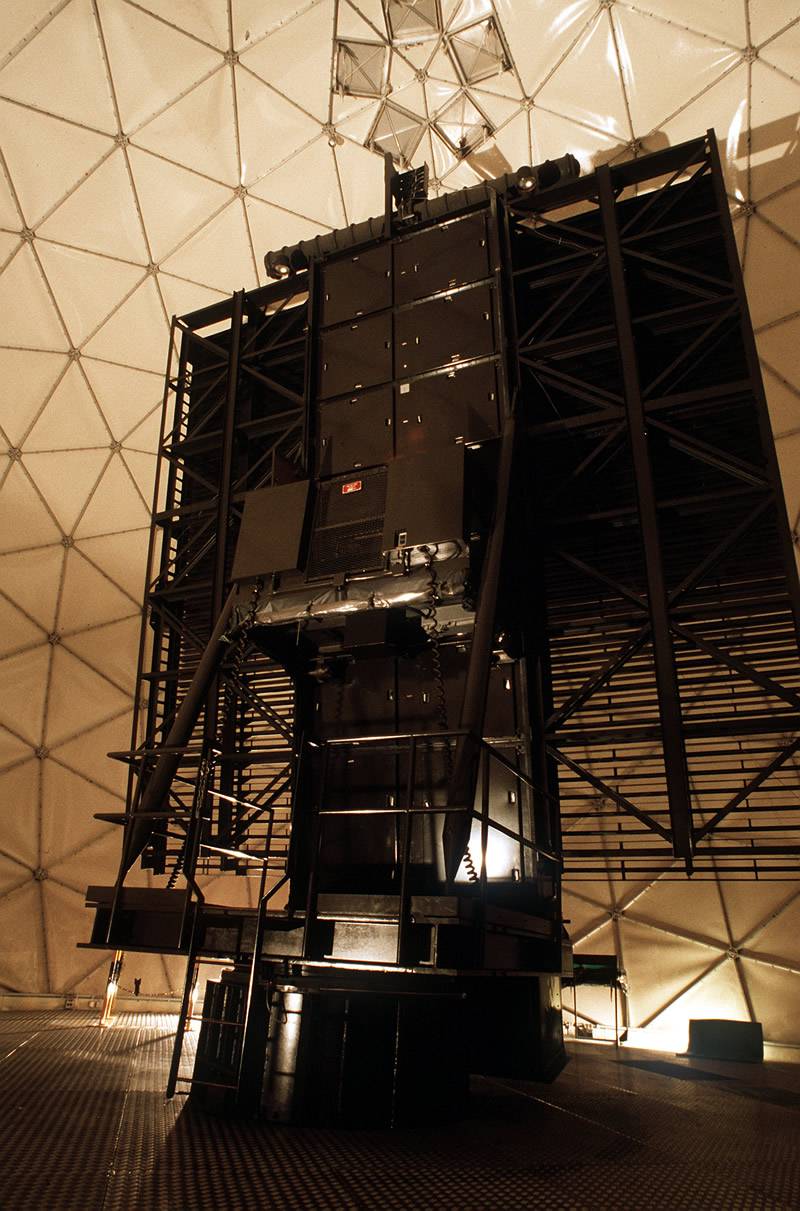
Antenna stationary radar AN / FPS-117 under the radio transparent dome
Unlike the AN / FPS-117, the station type AN / FPS-124 with a detection range of 110 km was originally designed as a stationary station for use in the far north. Particular attention during the creation of this station was paid to the possibilities for detecting low-altitude targets.
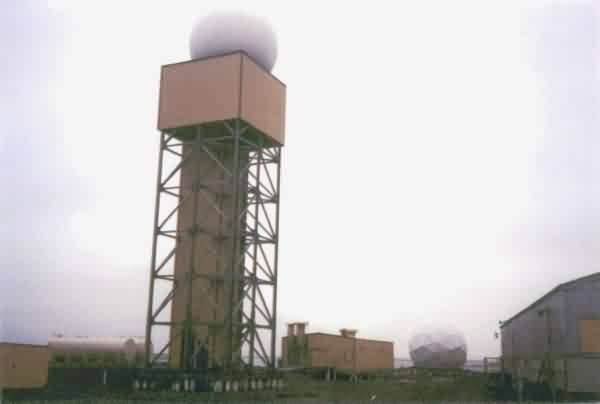
Thanks to the replacement of the highly automated AN / FPS-124 radar stations built in 60-70-s, it was possible to increase the reliability of the air monitoring system in the polar latitudes and reduce operating costs several times. Radar AN / FPS-117 and AN / FPS-124 of the "North" system are installed on capital concrete bases, receiving and transmitting antennas for protection from adverse meteorological factors are closed by radio-transparent domes.
Placement scheme in the United States and Canada and the AN / FPS-117 radar detection zone (in red) and AN / FPS-124 low-flying target detection stations (in blue)
If the AN / FPS-117 radar is often used autonomously, the short-range stations of the AN / FPS-124 type are deployed as part of integrated radar posts. The chain of such posts still, although on a smaller scale than in the past, exists in the territories of Alaska, Canada and Greenland. Information exchange within the “North” system is carried out via cable lines and satellite and radio relay communication channels. A few years ago, Lockheed Martin received $ 20 million to upgrade the radar system included in the North system.
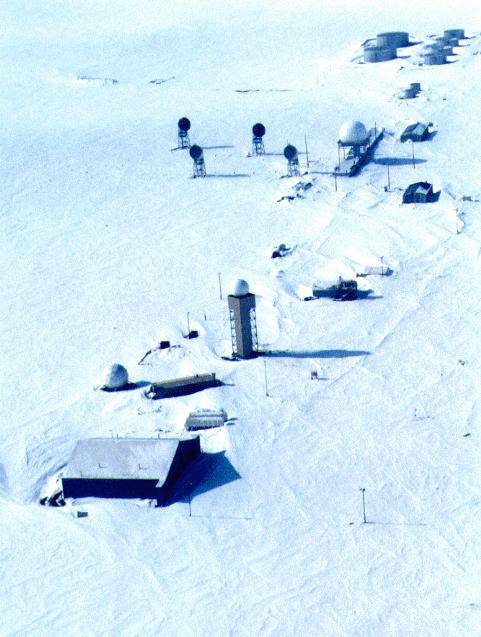
Radar post in Alaska as part of the radar AN / FPS-117 and AN / FPS-124
Currently, approximately 110 fixed radar stations are operating in the continental United States. Approximately 15% of them are old military stations such as AN / FPS-66 and AN / FPS-67. The rest are ARSR-1 / 2 / 3 / 4 radars (Air Route Surveillance Radar - air route surveillance radar), differing in hardware, computational tools and software. They are shared by the USAF and the Federal Aviation Administration of the USA (FAA - Federal Aviation Administration).
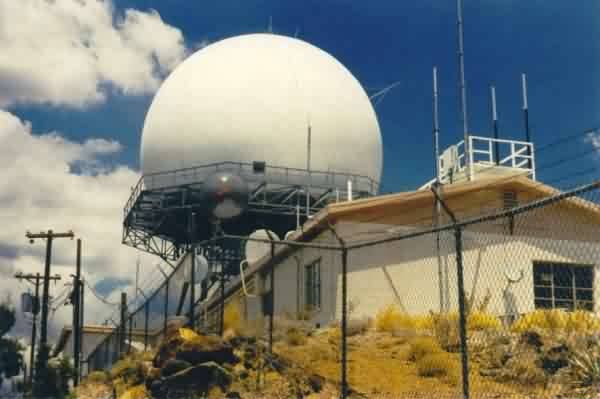
The most modern stations ARSR-4 are a civilian version of the three-coordinate radar AN / FPS-130 produced by Northrop-Grumman. The detection range of the ARSR-4 large high-altitude targets reaches 450 km. At a distance of 100 km, the station is able to detect targets flying at extremely low altitudes. Due to the high reliability, the ARSR-4 radar stations operate in automatic mode, transmitting information via communication channels. To protect against wind and precipitation, ARSR-4 radars are placed under a radio-transparent dome with a diameter of 18 meters. From 1992 to 1995, the ARSR-44 dual-use XLS radar was deployed in the United States in the United States. They operate and implement a two-way exchange in the interests of NORAD and the unified airspace surveillance system for air defense-ATC JSS (JSS - Joint Surveillance System). In the middle of 4-x the cost of one station of the type ARSR-90, depending on the place of construction, was $ 4-13 million.
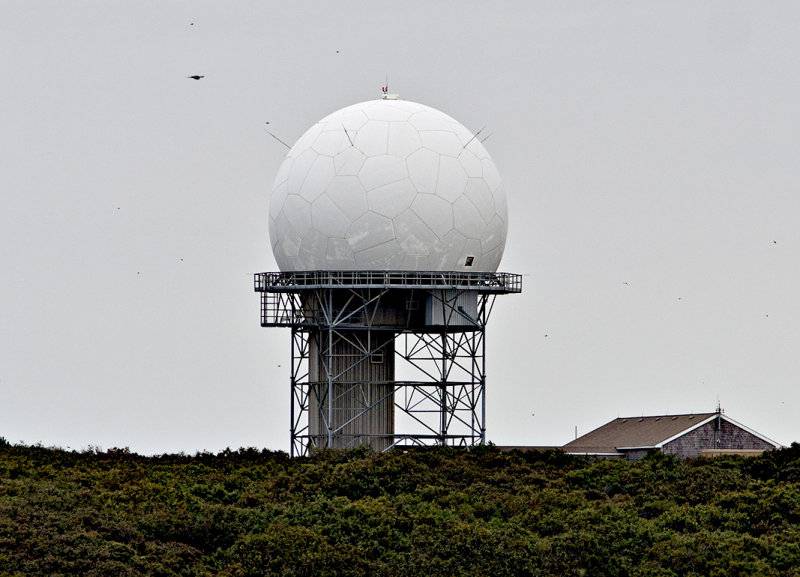
As of the middle of 2015, the AN / FPS-66 and AN / FPS-67, AN / FPS-117, AN / FPS-124, ARSR-1 / 2 / 3 / 4 stationary radars AN / F / N / 70 / / AN / mobile stations were used in the NORAD system. TPS-75 / 78 / 10. Mobile radars, as a rule, do not carry constant duty and are a kind of reserve in case of failure of stationary radar or, if necessary, strengthening of air control in some direction. Military radar service 3 thousands of troops, about half of them - the national guards. In the future, it is planned to equip the US military with new observation stations - the 80DELLR and the multipurpose AN / TPS-XNUMX, as well as the modernization and extension of the operating life of existing radars.
To be continued ...
Based on:
https://fas.org/nuke/guide/usa/airdef/an-fps-20.htm
https://fas.org/nuke/guide/usa/airdef/an-fps-124.htm
http://www.lockheedmartin.com/us.html
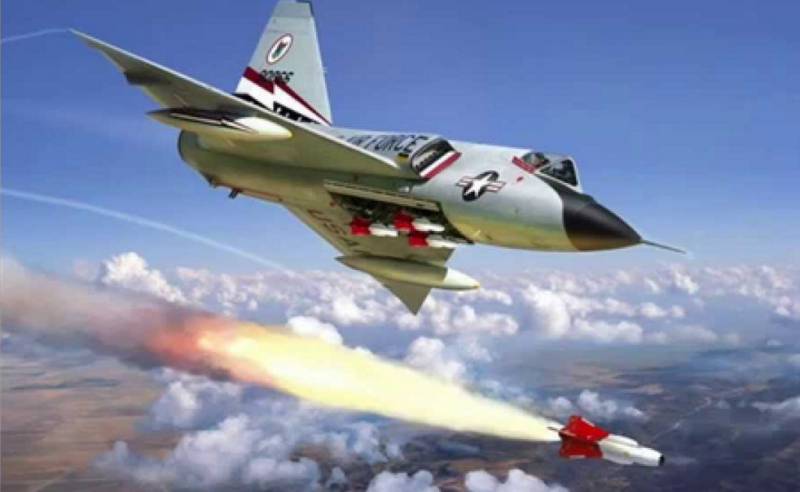
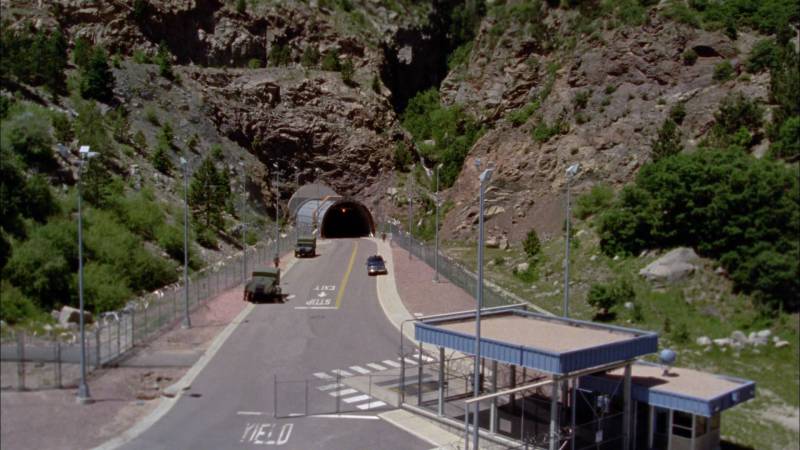
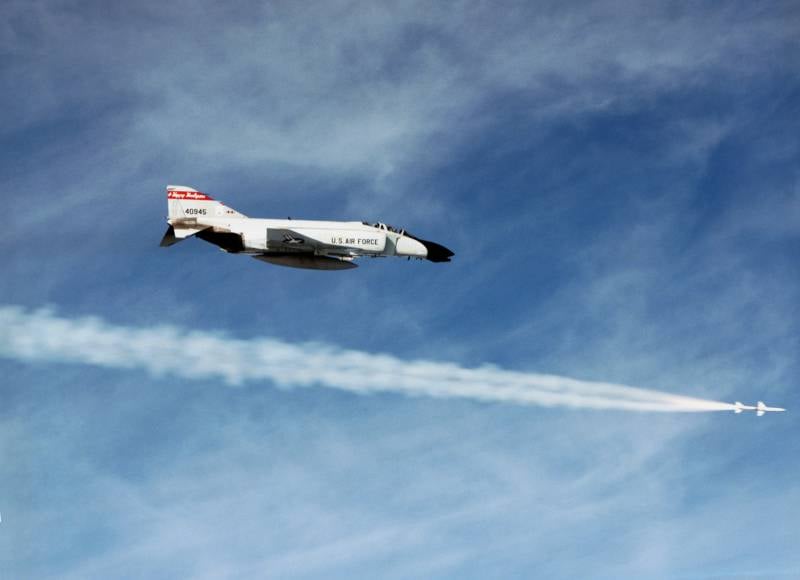
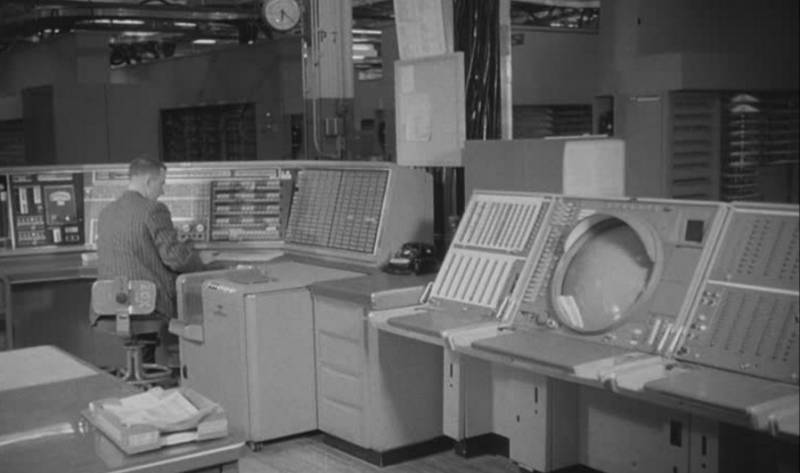
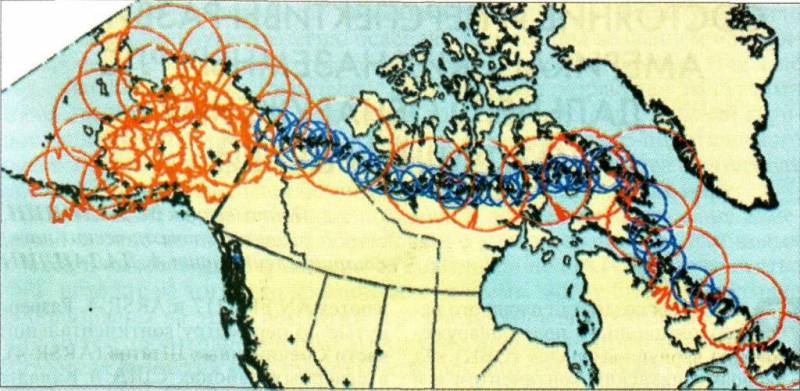
Information